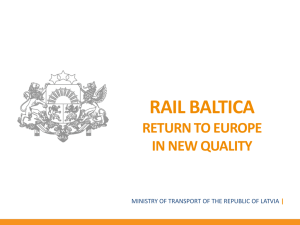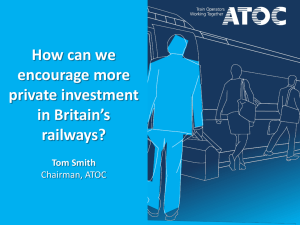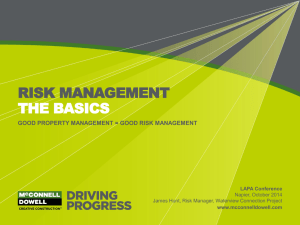Tuesday - 1130-1230 Sussman Strategic Rail Finance SCORT 2013
advertisement
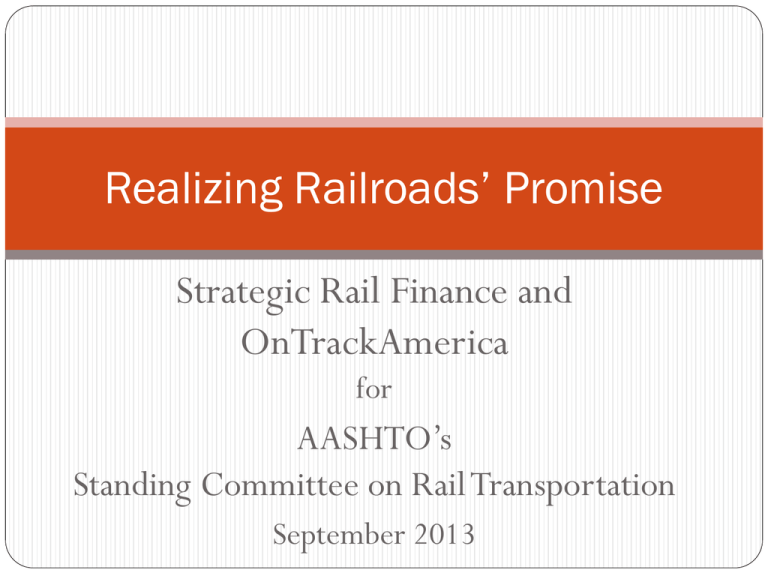
Realizing Railroads’ Promise Strategic Rail Finance and OnTrackAmerica for AASHTO’s Standing Committee on Rail Transportation September 2013 Introductory Comments In 1996, Iowa Interstate came to me for a solution to how they could secure a $13,000,000 track upgrade loan by doing a sales-leaseback of their 550-miles of track, so I began studying everything about their financials and their history. When I learned that ADM had recently purchased 48% of Iowa Interstate, plus a 3% option, I knew I was heading toward the answer. Due to recent mergers ADM was concerned that they could be left with only UP service and wanted to have the ability to control Iowa Interstate by exercising the option to gain majority interest. Eureka, I directed my client to ask ADM to guarantee the new financing because with such a large commitment already they would certainly want to ensure the quality of the track and service. Railroad finance requires understanding each and every railroad in its own light. It defies cookie cutter approaches and this is one of the reasons why railroads, and rail projects, particularly the smaller ones, have been undercapitalized. But all of our efforts and success in project finance will not deliver the railroad system we want and need in this country unless we address one fundamental problem—capitalism’s ongoing drive toward commercial and political competition rather than collaboration for everyone’s benefit. In the 15 years since I started coming to SCORT, the freight rail network has shrunk 6%, enough to cross the United States three times. Since 1990, the rail network has shrunk by 22%. Competition is an incomplete and insufficient regulatory principle for large infrastructure systems. We face a critical moment in our country. Can we reorient our commercial activity and related public policy to support what is best for all of us, not just a few winners, because really there is no marketplace that magically repurposes all the individual competing activities and delivers an efficient transportation system? Introductory Comments (cont’d) We need to finance the whole system not just the largest projects, trunk lines and terminals. We water the roots of the tree, not the trunk. That is why I maintain a commitment to advocating for shortlines and all size rail transactions, not just the largest, in spite of our industry’s most over-looked influence—the business mantra, “it takes as much trouble to do a small deal as a big one so why do the small ones”? I invite you to embrace a new principle for our future—it always makes sense to do the small deals, they all matter, we all matter, and every small town, small railroad, and small shipper matters. We can and must do better than orienting around “the last mile” by truck, because it isn’t actually the last mile, it’s the last 250 miles, and we all live inside those last 250 miles, the ones with the trucks whizzing by. One of the reasons given for diminished rail market share is the supposed inflexibility of rail compared to truck. Is that really true? Imagine the truck driver who is asked to drive off the paved highway and bushwhack across a muddy field. Trains go where we build track and trucks only go where we build roads. That only leaves the question of which do we want to plan our nation around. Isn’t it time to lay more track, instead of tearing it up? Isn’t it time to integrate modes, not pit them against each other. I believe that we can establish a national commitment to double and then triple rail utilization if we reverse the ongoing demise of the branch line network and return to serving as many towns, cities, and shippers as possible. Is This the Rail Renaissance? $50B in Capital Investment in 2012 and 2013 Responded quickly to shale oil boom But… Current growth is still fossil-fuel based which is a shortterm business approach given future regulations to address climate change Rail revenue is still only 10% of truck revenue Logistics is trending toward consolidation, standardization, and terminalization Less direct rail service, more trucks where we can least afford them The Other Side of Intermodalism: Industrial and commercial development built without direct rail service Increased Local Truck Traffic Even if an existing rail line is close by More Intermodalism, More Trucks: Existing rail spurs torn up … further weakening branch lines Small Town America is Getting Big City Truck Traffic Even in historically rail-rich towns like York, PA The world’s largest automated grocery facility, York County, PA Built without rail service; requested later (too late) Convenient to I-83, Not to a Railroad: What national infrastructure plan does this follow? Bumper to Bumper Truck Traffic on I-83 Opportunity for Dramatic Growth of Rail: Ongoing population growth Cities are increasing in population Reindustrialization of North America Supply chains are going to shorten as externalized costs of transportation are priced into the market Increasing appreciation for the environmental, capital, and space efficiencies of rail Ongoing freight market demand projected for 30+ years Renewed interest in passenger service on rail We Must Use our Capital Wisely Railroads are as important to a well-functioning modern society as clean water and reliable power “Projects of National Significance” require projects of local significance Shortline rail investments should be at the center of our country’s plans for economic and environmental revitalization Competition is an incomplete regulatory principle for crucial infrastructure systems; emphasis needs to switch to maximizing service; multiple shipping options benefit all Space is a critical and finite form of capital; one train equals a 27-mile truck convoy Rail project revolving loan programs work State Rail Loan Program Repayment History STATE OR AGENCY NUMBER OF LOANS DOLLARS LENT DEFAULTS Wisconsin 2013 105 $117,000,000 0 Illinois 2013 5 $6,434,157 0 Michigan 2012 37 $15,300,000 1 Idaho 2013 3 $3,770,475 0 Iowa 2011 108 $69,761,000 0 Minnesota 2013 225 $95,700,000 0 Kansas 2013 46 $16,903,380 0 Mississippi 2007 35 $12,000,000 0 Ohio 2013 40 $33,464,731 1 Montana 2013 4 $2,078,004 0 SBA 2013 34 $14,400,000 1 650 $380,337,988 2 TOTALS (as of year indicated) Let’s Think Together! Rail loading infrastructure loan program for shippers needing sidings, docks, and/or equipment Loss reserve mechanism to amplify limited public dollars States can take second positions on track or land OTA’s “Freight System Action Plan” for direct impact OTA’s “Freight Transportation Land Use Strategy” Treat rail ROW’s as “beach-front property” Offer permitting credits for using railroad ROW’s for railserved development Make a “Transportation Plan” review process as ubiquitous as Water and Sewer Plan reviews are now OTA’s “Lets Put RRIF to Work” Equal to having the 4th largest hedge fund in the world 100% focused on rail—$34B still available Gather stakeholder commitment to program improvements Applicants require more guidance, coaching, and examples Eliminate FRA asset valuation haircut Institute private-sector like innovation States can support by investing in the costs of: Independent Financial Analyst Environmental Assessment Credit Risk Premium Application preparation Contribution of collateral such as state-owned track SRF Helps Iowa Northern Railway Leverage RRIF Coordination of Multiple Funding Sources Added to the Value of a RRIF Loan FRA Railroad Rehabilitation and Improvement Financing (RRIF) loan for $25,520,000 (Track and Yards) Local Iowa bank funding of $1,750,000 (Land) IDOT low-interest loan for $600,000 (Track-Second Position) National bank financing for $2,000,000 (Locomotives) Private Equity investment of $10,000,000 (Tank Farm) Result: $40mm in growth financing for Class III railroad Concluding Questions: Should we continue to subsidize freight truck transportation with its high externalized societal costs? Do we really want to continue abandoning rail lines in large cities, small towns, and rural America? When will the United States return to building out an expanded branch line network to serve a growing population? How can we integrate collaboration with competition to improve our regulatory environment for growth? How can we all contribute to Realizing Railroads’ Promise? Thank you for all of your good work! Michael Sussman, President Strategic Rail Finance & OnTrackAmerica Philadelphia, PA msussman@strategicrail.com AASHTO SCORT Annual Meeting 2013 Thanks to volunteer Kyle Bardo for gathering loan repayment history from state DOT’s


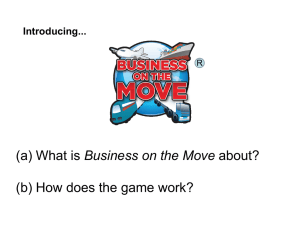
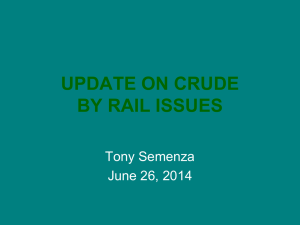
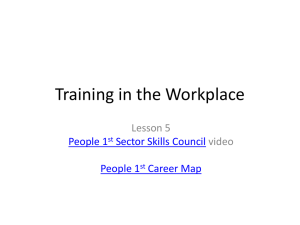
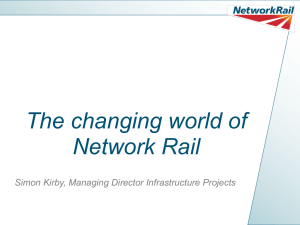
![lecture_8_(2)lscm[1] - Head Scratching Notes](http://s2.studylib.net/store/data/005495268_1-06056aa40ae4298d0ab041c29bbcab92-300x300.png)
